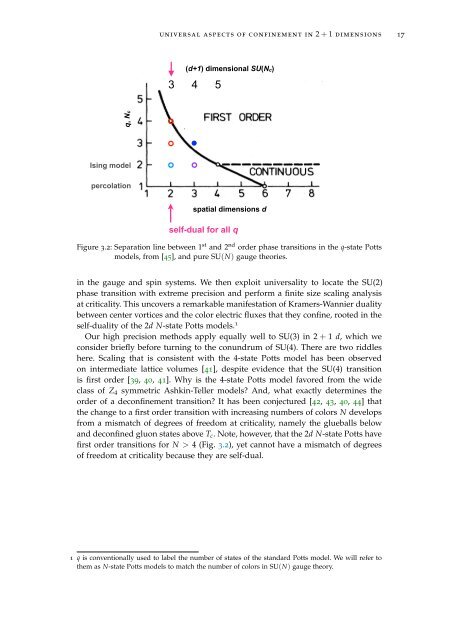Topology, symmetry, and phase transitions in lattice gauge ... - tuprints
Topology, symmetry, and phase transitions in lattice gauge ... - tuprints
Topology, symmetry, and phase transitions in lattice gauge ... - tuprints
Create successful ePaper yourself
Turn your PDF publications into a flip-book with our unique Google optimized e-Paper software.
universal aspects of conf<strong>in</strong>ement <strong>in</strong> 2 + 1 dimensions 17<br />
(d+1) dimensional SU(Nc)<br />
3 4 5<br />
q, Nc<br />
Is<strong>in</strong>g model<br />
percolation<br />
spatial dimensions d<br />
self-dual for all q<br />
Figure 3.2: Separation l<strong>in</strong>e between 1 st <strong>and</strong> 2 nd order <strong>phase</strong> <strong>transitions</strong> <strong>in</strong> the q-state Potts<br />
models, from [45], <strong>and</strong> pure SU(N) <strong>gauge</strong> theories.<br />
<strong>in</strong> the <strong>gauge</strong> <strong>and</strong> sp<strong>in</strong> systems. We then exploit universality to locate the SU(2)<br />
<strong>phase</strong> transition with extreme precision <strong>and</strong> perform a f<strong>in</strong>ite size scal<strong>in</strong>g analysis<br />
at criticality. This uncovers a remarkable manifestation of Kramers-Wannier duality<br />
between center vortices <strong>and</strong> the color electric fluxes that they conf<strong>in</strong>e, rooted <strong>in</strong> the<br />
self-duality of the 2d N-state Potts models. 1<br />
Our high precision methods apply equally well to SU(3) <strong>in</strong> 2 + 1 d, which we<br />
consider briefly before turn<strong>in</strong>g to the conundrum of SU(4). There are two riddles<br />
here. Scal<strong>in</strong>g that is consistent with the 4-state Potts model has been observed<br />
on <strong>in</strong>termediate <strong>lattice</strong> volumes [41], despite evidence that the SU(4) transition<br />
is first order [39, 40, 41]. Why is the 4-state Potts model favored from the wide<br />
class of Z 4 symmetric Ashk<strong>in</strong>-Teller models? And, what exactly determ<strong>in</strong>es the<br />
order of a deconf<strong>in</strong>ement transition? It has been conjectured [42, 43, 40, 44] that<br />
the change to a first order transition with <strong>in</strong>creas<strong>in</strong>g numbers of colors N develops<br />
from a mismatch of degrees of freedom at criticality, namely the glueballs below<br />
<strong>and</strong> deconf<strong>in</strong>ed gluon states above T c . Note, however, that the 2d N-state Potts have<br />
first order <strong>transitions</strong> for N > 4 (Fig. 3.2), yet cannot have a mismatch of degrees<br />
of freedom at criticality because they are self-dual.<br />
1 q is conventionally used to label the number of states of the st<strong>and</strong>ard Potts model. We will refer to<br />
them as N-state Potts models to match the number of colors <strong>in</strong> SU(N) <strong>gauge</strong> theory.
















